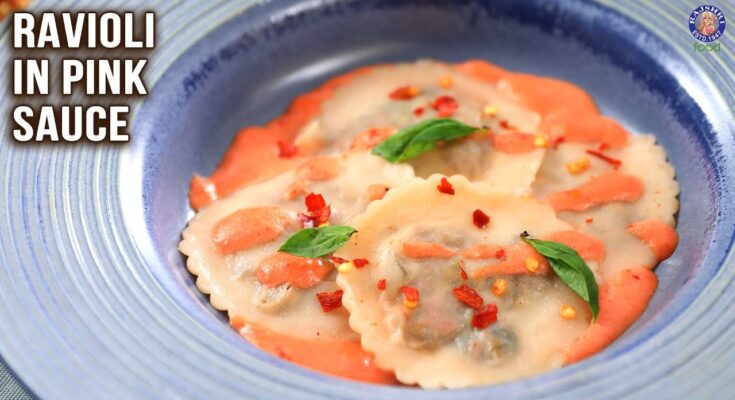Ravioli Filling Recipe: Who doesn’t love a plate of rich, flavorful ravioli smothered in sauce and filled with a surprise inside? Store-bought versions are quick, sure, but nothing compares to the taste and satisfaction of making your own ravioli filling from scratch. Making ravioli at home is like turning your kitchen into a little Italian trattoria. And guess what? It’s not as complicated as it sounds. The magic lies in the filling – whether you’re craving something cheesy, meaty, or veggie-packed.
Creating your own ravioli filling allows complete control over the ingredients, flavors, and texture. You’re not limited to what’s in a plastic tray from the supermarket. Want more garlic? Done. Need a meatless version? No problem. Dreaming of something spicy? Go for it. Plus, homemade fillings are often healthier, as you can skip the preservatives and artificial flavors.
So, if you’ve been curious about trying your hand at ravioli, this guide will walk you through everything – from picking the perfect ingredients to crafting a rich, flavorful filling that’ll make your ravioli unforgettable.
Ingredients You’ll Need
To get started with any great ravioli, you need to gather the right ingredients. While the pasta dough plays a big part in the final product, the filling is where your creativity really shines. Let’s talk about what you need to make a delicious, crowd-pleasing filling.
Essential Ingredients
Here’s what you’ll typically need:
- Ricotta Cheese – A soft, creamy cheese that forms the base of most traditional fillings.
- Parmesan Cheese – Adds a salty, nutty depth to the filling.
- Egg Yolk – Helps bind the filling and adds richness.
- Salt and Pepper – Essential for seasoning and balancing flavors.
Optional but Flavor-Boosting Ingredients
Depending on your flavor goals, consider adding:
- Spinach – Sautéed and chopped finely for a classic vegetarian option.
- Nutmeg – Just a pinch adds warmth and complexity to cheese-based fillings.
- Mushrooms – For earthy, umami-packed veggie fillings.
- Ground Meat – Beef, pork, or even Italian sausage can be used for meat lovers.
- Herbs – Fresh parsley, basil, oregano, or thyme can elevate any filling.
- Garlic – Because everything is better with garlic.
With these ingredients in hand, you can mix and match to create your ideal ravioli center. The trick is to keep the filling balanced – not too wet, not too dry – so it holds together inside the pasta.
Choosing the Right Cheese for Ravioli Filling
Let’s be honest—cheese is often the star of the ravioli show. If you’re aiming for that creamy, indulgent bite, cheese is where it all begins. The good news? There’s no one right cheese. Instead, think of cheese as your canvas and flavor as your paint.
Ricotta: The Classic Base
Ricotta cheese is the go-to base for many traditional ravioli fillings, and for good reason. Its mild flavor pairs well with everything from herbs to veggies to meats. It’s soft, spreadable, and creamy, making it easy to work with. When using ricotta, be sure to drain it slightly if it’s too wet. Excess moisture can make your pasta soggy or cause the filling to ooze out.
Adding Parmesan for Flavor
Parmesan is sharp, salty, and packed with umami. Mixing a few tablespoons into your ricotta brings depth and contrast. Freshly grated Parmesan is best—it melts better and has a cleaner, nuttier taste.
Other Cheese Options
- Mozzarella: Great for adding that gooey, stretchy texture. Use it sparingly with other cheeses.
- Goat Cheese: Perfect for a tangy, creamy filling. Pairs beautifully with herbs or roasted veggies.
- Fontina or Asiago: Melt-friendly cheeses that bring richness to the filling.
Cheese combinations are endless, so feel free to experiment. Just keep the ratio right—too much soft cheese and your filling might get runny; too much hard cheese and it could turn grainy.
Meaty vs. Vegetarian Fillings
Let’s talk filling styles. Are you all about that savory, hearty, meat-filled bite? Or do you prefer a lighter, veggie-forward option? Either way, you can craft a killer ravioli filling with a few pantry staples and a little kitchen love.
Meaty Options
- Ground Beef or Veal – Brown it with garlic, onion, and a bit of tomato paste for richness.
- Italian Sausage – Full of seasoning and spice, this makes for a bold, flavorful filling.
- Chicken – For a leaner filling, try shredded or ground chicken with herbs and cheese.
- Prosciutto or Pancetta – Finely diced and folded into cheese fillings for a salty kick.
When using meat, make sure it’s fully cooked before stuffing. Cool it down and chop it finely for even texture and easy stuffing.
Vegetarian Favorites
- Spinach and Ricotta – The classic combo. Sauté the spinach first, squeeze out moisture, and mix with cheese.
- Mushroom and Thyme – Sautéed mushrooms bring depth and a meaty bite without actual meat.
- Pumpkin or Butternut Squash – Roasted and mashed, these are sweet and savory, especially when mixed with sage and a touch of brown butter.
- Zucchini, Peas, or Artichokes – Get creative with seasonal veggies.
The key with vegetarian fillings is to cook down any vegetables to remove excess moisture. A soggy filling can ruin your ravioli faster than you can say “al dente.”
Step-by-Step Ravioli Filling Preparation
Making ravioli filling isn’t just tossing ingredients in a bowl—it’s about layering flavor, creating texture, and getting the consistency just right. Follow these steps for the perfect stuffing.
Step 1: Prepare Your Ingredients
Chop your herbs, grate your cheese, sauté your vegetables or meats. Get everything ready before mixing. If you’re using frozen spinach or veggies, thaw and drain them well. Prep is everything—it ensures your filling comes together quickly and smoothly.
Step 2: Cook the Components
Whether it’s browning meat, wilting spinach, or caramelizing mushrooms, make sure everything is cooked properly. Let your ingredients cool before mixing. Hot ingredients will melt the cheese and potentially change the texture of your filling.
Step 3: Mix and Season
Combine your cheeses, cooked veggies or meats, and seasonings in a mixing bowl. Taste the filling before adding the egg yolk—adjust seasoning as needed. Once it’s seasoned to your liking, add the egg yolk to bind it all together.
Step 4: Cool Before Stuffing
Place the mixture in the fridge for 15–30 minutes. A cool filling is easier to handle and won’t seep through the pasta dough. If your filling feels too loose, add more Parmesan or breadcrumbs to firm it up.
Tips for a Smooth Filling Texture
Getting that perfect, spoonable filling texture is half the battle when making ravioli. Too wet? It’ll ooze out and make sealing the pasta difficult. Too dry? It’ll feel grainy and unappetizing. Here’s how to get it just right.
Drain Everything Properly
Ricotta and cooked vegetables often hold a surprising amount of moisture. Wrap ricotta in cheesecloth and let it drain for 30 minutes to an hour. Spinach or mushrooms? Press them between paper towels after sautéing to remove excess water.
Use the Right Binding Agents
An egg yolk does wonders for bringing a filling together, but if you need a firmer texture, a small spoonful of breadcrumbs or grated hard cheese like Parmesan will help absorb moisture without overpowering the taste.
Blend or Mash
For ultra-smooth fillings like pumpkin or butternut squash, use a food processor or potato masher to get a consistent, silky texture. It’s especially important if you’re using firmer cheeses or chunkier vegetables.
Chill Before Filling
Once your mixture is ready, place it in the fridge. A cold filling is easier to handle, less likely to spread, and makes sealing the ravioli a breeze.
Creative Flavor Variations to Try
Feeling bold or bored with the classics? There’s a whole world of ravioli filling combinations out there. Whether you’re entertaining or just cooking for yourself, these ideas will take your ravioli game to the next level.
Sweet and Savory Combos
- Pear and Gorgonzola – A sophisticated blend of sweet fruit and tangy cheese.
- Fig and Prosciutto – Salty and sweet with a creamy ricotta base.
- Roasted Pumpkin and Sage Butter – Earthy, nutty, and fall-perfect.
Herb-Forward Mixes
- Basil and Lemon Ricotta – Light and zesty with summer vibes.
- Thyme and Goat Cheese – A creamy, aromatic pairing great with mushroom sauces.
- Parsley, Mint, and Pea – A green, garden-fresh option that’s perfect for spring.
Spicy or Exotic Ideas
- Spicy Sausage and Roasted Red Pepper – Bring the heat with crushed chili flakes.
- Curry Potato and Pea – An Indian-inspired filling that’s hearty and unexpected.
- Truffle Mushroom – Decadent, deep-flavored, and perfect for special occasions.
The only limit is your imagination (and maybe what’s in your fridge). Try combinations you’ve never seen before—you might invent your own signature ravioli.
How to Store and Freeze Ravioli Filling
You’ve made a big batch—awesome! But maybe you’re not stuffing them all today. Here’s how to safely store your ravioli filling for later.
Short-Term Storage
If you plan to use the filling within a couple of days, transfer it to an airtight container and refrigerate. Most fillings will last 2–3 days in the fridge. Make sure it’s chilled as soon as possible after preparation.
Freezing Your Filling
Yes, you can freeze ravioli filling! Whether cheese-, meat-, or veggie-based, freezing helps you save time on your next pasta night.
- Place the filling in a freezer-safe bag or container.
- Press out excess air to prevent freezer burn.
- Label it with the date.
- Use within 1–2 months for the best flavor.
When ready to use, thaw the filling overnight in the fridge. Avoid microwaving to defrost, as it can separate or overheat delicate dairy ingredients.
Common Mistakes to Avoid
Even pros can mess up ravioli. Let’s look at a few common slip-ups and how to steer clear of them:
1. Overfilling the Pasta
Too much filling makes it hard to seal the ravioli and may cause bursting during cooking. Stick to about a teaspoon per square and spread it evenly.
2. Using Watery Filling
Whether it’s ricotta that wasn’t drained or sautéed mushrooms that weren’t dried out, too much liquid makes for a messy outcome. Always drain well and chill the mix.
3. Underseasoning
Taste your filling before the egg goes in. Cheese alone isn’t salty enough. Add salt, pepper, and herbs generously—ravioli is only as tasty as what’s inside.
4. Not Letting the Filling Cool
Hot filling will melt your pasta dough and mess up the sealing. Always chill it first.
5. Skipping the Binder
Without egg yolk or breadcrumbs, the filling won’t hold together. That means clumps, leaks, and sadness. Use at least one good binder.
What Sauces Pair Best with Ravioli Fillings
The sauce you choose can make or break your ravioli. You want something that complements your filling, not overpowers it.
For Cheese or Veggie Fillings:
- Brown Butter and Sage Sauce – Nutty and light, perfect for ricotta or squash.
- Tomato Basil Sauce – Classic and balanced; works with spinach and cheese ravioli.
- Alfredo or Cream Sauce – Rich and indulgent for mushroom or goat cheese fillings.
For Meat-Based Fillings:
- Bolognese – A hearty tomato-meat sauce to double down on flavor.
- Garlic and Oil (Aglio e Olio) – Lets the meat shine without too much fuss.
- Red Wine Reduction Sauce – Elegant and intense for beef or sausage ravioli.
Experiment and match sauces to your mood. And don’t forget toppings: freshly grated cheese, toasted nuts, or a drizzle of truffle oil can take it over the top.
Step-by-Step Guide to Assembling Your Ravioli
Alright, your filling is perfect, flavorful, and chilled. Now comes the fun part: turning that delicious mix into actual ravioli. This part might seem intimidating, but with a little patience, you’ll be cranking out pasta like a seasoned Italian nonna.
Step 1: Roll Out the Dough
Use a pasta machine or a rolling pin to flatten your dough into thin sheets. Aim for about 1/16 inch thick. You want it thin enough to be tender when cooked but not so fragile that it tears.
Pro tip: Dust with flour as you go to keep the dough from sticking.
Step 2: Portion the Filling
Using a spoon or piping bag, place small mounds of filling onto one sheet of pasta. Leave about an inch between each portion so you have space to seal them properly.
Pro tip: Stick to about 1 teaspoon of filling per ravioli—less is more when it comes to sealing!
Step 3: Seal the Ravioli
Lay another sheet of pasta over the top, gently pressing around each mound to remove air bubbles. Use your fingers or a fork to seal the edges.
Optional: Use a ravioli cutter or knife to trim and shape your pasta. Crimp edges if desired.
Step 4: Boil and Serve
Bring a large pot of salted water to a boil. Add ravioli and cook for 3–4 minutes, or until they float. Drain gently and serve with your chosen sauce.
You’ve done it—homemade ravioli filled with love and flavor.
Best Tools to Use for Ravioli Making
Having the right tools on hand can make your ravioli-making experience smoother, faster, and more fun. Here’s what we recommend:
1. Pasta Roller
Manual or electric, a pasta roller helps achieve that paper-thin dough that ravioli dreams are made of. It saves time and ensures consistency.
2. Ravioli Mold or Stamp
These tools help shape uniform ravioli and press out air bubbles. Molds are great for batches, while stamps add a classic, rustic look.
3. Pastry Brush
Useful for brushing water or egg wash along the dough edges to help seal them.
4. Dough Cutter or Knife
A sharp cutter ensures clean lines and even shapes. Crimping wheels also give a decorative edge.
5. Slotted Spoon
Essential for lifting ravioli out of boiling water without breaking them.
Investing in just a couple of these tools can make a big difference, especially if you plan to make ravioli regularly.
Ravioli Filling for Special Diets
Whether you’re catering to dietary needs or just want a lighter option, ravioli fillings can be easily adapted.
Vegan Ravioli Filling
Skip the cheese and eggs—try these tasty plant-based options:
- Tofu and Spinach – Crumbled tofu mimics ricotta when blended with nutritional yeast and herbs.
- Roasted Veggie Mash – Blend roasted squash, carrots, or cauliflower with olive oil and garlic.
- Lentil and Mushroom – Protein-packed and savory.
Gluten-Free Ravioli
While the filling is usually gluten-free by nature, you’ll need gluten-free pasta dough to go with it. Use chickpea flour, rice flour, or a gluten-free all-purpose mix for best results.
Low-Carb or Keto Fillings
Stick to meats, cheeses, and low-carb veggies like spinach, kale, or mushrooms. Use almond flour or cheese-based pasta alternatives to keep carbs in check.
There’s no reason to miss out—ravioli can work for nearly any diet with the right adjustments.
Serving Suggestions and Side Dishes
So you’ve made perfect ravioli… now what? Let’s round out the meal with sides that complement the rich, satisfying filling.
Salads
- Arugula Salad with Lemon Vinaigrette – A peppery, acidic contrast to creamy ravioli.
- Caprese Salad – Fresh tomatoes, mozzarella, and basil brighten up a heavy pasta dish.
- Simple Mixed Greens – Tossed with balsamic or vinaigrette for a light touch.
Breads
- Garlic Bread – Because carbs on carbs is never a bad idea.
- Focaccia – Rosemary and sea salt make it a flavorful pairing.
- Crusty Artisan Bread – Ideal for sopping up that extra sauce.
Wines and Drinks
- White Wine – Pinot Grigio or Chardonnay with cheese or veggie fillings.
- Red Wine – Chianti or Sangiovese with meat-based ravioli.
- Sparkling Water or Lemonade – For non-alcoholic balance.
A little thought into your sides can elevate a simple ravioli dinner into a full Italian experience.
FAQs about Ravioli Filling Recipe
Q1: Can I make ravioli filling ahead of time?
Yes! Most fillings can be made 1–2 days in advance and stored in the refrigerator. Just make sure they’re well covered.
Q2: How do I know if my ravioli filling is too wet?
If the mixture looks runny or pools on the spoon, it’s too wet. Add breadcrumbs or more cheese to firm it up before using.
Q3: Can I freeze leftover filling?
Absolutely. Store in a freezer-safe bag or container, remove excess air, and use within 2 months for best flavor.
Q4: What’s the best filling for kids or picky eaters?
Stick with ricotta and mozzarella with a little Parmesan and mild herbs like parsley. It’s creamy, neutral, and always a hit.
Q5: How much filling should I use per ravioli?
Usually, 1 teaspoon of filling per ravioli is enough. Overfilling can cause them to burst during cooking.
Conclusion
Making ravioli from scratch might seem like a big job, but once you get the hang of it, it becomes an incredibly rewarding and delicious ritual. From crafting the perfect filling to sealing your little pasta pillows of joy, each step offers a chance to add your own personal touch. Whether you go for a rich meaty mixture, a creamy cheese blend, or a bold vegetarian combo, the options are endless—and always better homemade.
Start with the basics, explore the variations, and before you know it, you’ll be inventing your own signature ravioli recipes. Buon appetito!



